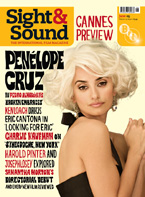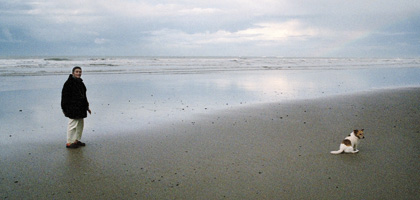Primary navigation


As an honest and moving portrait of a year in the life of a small rural community in mid Wales, Gideon Koppel's charming and naturalistic film beats its inspiration Dylan Thomas hands down, says John Banville
At the close of his recent and superb collection of essays, Gray's Anatomy, the political philosopher John Gray urges upon humanity a new quietism. "Other animals," he writes, "do not need a purpose in life. A contradiction to itself, the human animal cannot do without one. Can we not think of the aim of life as being simply to see?" It may seem an overly simplified exhortation given the dire predicament we have got ourselves into, yet would it not make at least a good start on the road to recovery from our present soul-sickness if we were to stand back and just look?
Gideon Koppel would surely agree that it would, if we take as evidence of his life philosophy his profound and utterly beguiling film sleep furiously. Not that it is a 'philosophical' film in any earnest or tendentious sense. On the contrary, on the surface it seems no more than a series of carefully chosen moments from a year in the life of a small rural community, Trefeurig in mid Wales, where Koppel's parents, German Jewish refugees, settled after the war, and where the film-maker grew up.
The title sleep furiously is a reference to Noam Chomsky, who in support of his linguistic theories famously offered "Colourless green ideas sleep furiously" as an example of a sentence that is nonsensical even though the grammar is perfectly correct. It is not clear what we are to take from this nudge in the ribs that Koppel delivers us; indeed the title, with its portentous lack of capitals, may put off some viewers, who might be forgiven for expecting yet another gnomic exercise in postmodernism. This would be a pity, for the film is blessedly free of pretentiousness and fashionable posing. It is simply - and it is simple in its sly way - a mutedly gorgeous, moving and deeply poetic work of art.
Koppel must be the unfussiest film-maker since Robert Bresson. He sets up his camera and lets the scene unfold before it, holding the lens steady through long takes and allowing his subjects to wander offscreen and back on again as their actions dictate. Frequently his people are at work - teaching a class of small children, shearing sheep, arranging a church altar, rehearsing a choir - so absorbed in their tasks that they seem oblivious to the camera's eye fixed intently on them. Surely miles of 16mm film stock - shot in colour at once bleached and sumptuous - was consumed in the project. Or perhaps the Welsh are 'naturals', effortlessly capable of acting the part of themselves.
It is Koppel's remarkable achievement to present the community of Trefeurig in such a straightforward manner, without heroics of spurious, piled-on 'emotion', while avoiding the usual clichés - eg Welsh people being 'natural singers' - and although he pays obeisance to Under Milk Wood, his film is less indulgent, and far less self-indulgent, than Dylan Thomas' play. These are real people, not 'characters' moulded and in?ated in the maker's mind. The editing by the masterly Mario Battistel was done in Paris, a deliberate choice according to Koppel, taken in order to put an extra distance between himself and his material so that he might, as he writes: "engage with the material more freely. That is to say, I could be less in?uenced by my relationship with what lay beyond the screen and could respond to the authenticity of the moment, in terms of what was evoked rather than what was illustrated." The result is a film immediate in its human moments and yet austere to the point of abstraction in what is communicated "beyond the screen".
If there is a central thread to the narrative it is the monthly visit by the mobile library van, driven by the librarian John Jones. Jones is a wonderful figure, and wonderfully representative in his vivid ordinariness of the time and the place. Man and van have their own signature tune, a jaunty little piano piece by the electronic composer Richard James, who calls himself Aphex Twin, which the viewer comes to greet with an exalted smile each time it returns - Koppel has written that music was a vital component from the outset, "not as an accompaniment, but as the different 'voices' of the key characters" - while the sight of the yellow van, frequently seen in long-shot creeping like a yellow bug through vast and lovely landscapes, is an emblem both of continuity and of the frailty of our human arrangements.
If Jones is, so to speak, the male lead, then the female star is Koppel's mother Pip. And what a star she is: tiny, crop-haired, drolly humorous, an elfin figure picking her way deftly through the film accompanied by her dog Daisy and Daisy's son Jack. She is the settled and accepted outsider, a reminder of the great and fearful world that broods beyond the confines of this little valley. In what Koppel tells us was the first sequence he shot, Pip climbs with Daisy to the grave of her husband and lays a stone there for remembrance - one thinks immediately of Beckett's great late text, Ill Seen Ill Said - then walks home, a distant, diminutive figure against a great stand of sunlit trees thrashing slowly, enormously, in the wind; the same trees are seen again towards the close of the film from the same distant perspective, but this time bare and motionless in a snow-covered landscape. These are two of the most beautiful and moving sequences in sleep furiously.
Indeed trees figure throughout; the very last, unforgettable image, after the credits have rolled, is of a single, leafing tree set seething by a passing breeze, as if a god were visiting there. The gods haunt this film, for we are in a kind of classic pastoral, where the nymphs are portly and wear aprons and make sponge cakes filled with jam, and the shepherds do not play pan pipes but tend their ?ocks with no less rough tenderness than did their Attic forebears. One of the most beautiful and mysteriously affecting sequences is shot from a high mountainside down into a rain-swept valley into which two lines of sheep straggle slowly from different directions to form a kind of ragged magic square. It is the inexplicable beauty of these images that one remembers long after the screen has gone dark.
The film-maker Alex Cox described sleep furiously as "the least anthropocentric film I have ever seen", and surely it is. Koppel's vision sets man in his true context, as a part of creation and not lord over it. He has spoken of his admiration for W.G. Sebald, and sleep furiously is in the line of that new kind of post-humanist but entirely humane art of which Sebald was a leading practitioner before his untimely death in 2001. Now more than ever we need films such as this: grave, measured, subtly comic and beautifully wrought, free of polemic and yet offering a new way of seeing that is as old as Arcady. sleep furiously is, simply, a masterpiece.